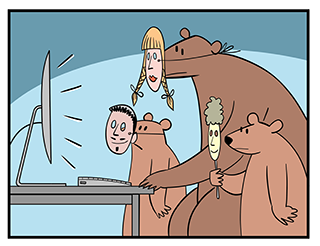Rise Of The Fake Audience

In the wake of the 2016 presidential election, many analysts have worried about the pervasive presence of fake news. Although this is a serious problem, most people don’t realize that this disinformation was widely propagated by the “fake audience.”
The fake audience is composed of dishonest propagandists who control phony online identities (sockpuppets) and artificially intelligent entities (bots) who pretend to be real human beings.
Propagandists use sockpuppets and bots to achieve for many reasons. These include:
- influencing election outcomes,
- discrediting political opponents,
- demoralizing people who disagree with the propagandist,
- isolating citizens in a wall of noise,
- hijacking public opinion polls,
- reorganizing the news agenda, and
- spreading disinformation.
Just one of these things would provide sufficient grounds for concern. By creating a fake audience, propagandists are taking power away from real human beings.
We live in an era in which people are deeply skeptical of traditional media. Many citizens think that messages in their social media feeds are more believable than stories reported by mainstream journalists. But there is a problem with this. When we get our news from social media, we are actually getting our news from the social media audience. Increasingly, this audience includes insincere users and deceptive bots who are intent on tricking us for political gain.
The fake audience also threatens online communities. On sites like Reddit, users come together to share personal stories, fears, jokes, and theories about the world. Most participants conceal their real-world identities with fanciful user names, but people have traditionally expected a certain amount of authentic self-expression in these digital spaces.
Fake audiences are fueled by two characteristics of our global computer networks. First, the fact that users can conceal their identity when surfing online has made it possible for people around the world to communicate with each other about a wide range of sensitive topics. Many scholars argue that the right to be anonymous is at the heart of truly ‘free’ speech. Second, global computer networks are highly accessible. Communication tools such as Twitter, Facebook, YouTube, Gmail, Tumblr, and Instagram are freely available to anyone who has an Internet connection.
Today’s global Internet would never have emerged if not for anonymity and accessibility. Sadly, these characteristics have been consciously exploited by deceptive entities who deploy the fake audience for financial and political reasons.
Some politicians claim the threat of the fake audience warrants more severe online regulations. They say we should protect the greater good by making anonymity impossible and reducing accessibility of the Internet. This would be a serious mistake. We must take steps to stop the fake audience, but we also need to respect online freedom. Social network providers should implement sensible solutions that don’t trample on the rights of users.
Education is one of these solutions. We should teach global citizens how to know when they are interacting with artificial entities. Rather can shutting down freedom and anonymity, we can learn how to tell the difference between the real and the contrived.
Just as acts of physical terrorism should not stop us from gathering for parades, concerts, and public demonstrations, the existence of the fake audience should not cause us to abandon the democratic aspirations which led to the creation of the Internet in the first place.
